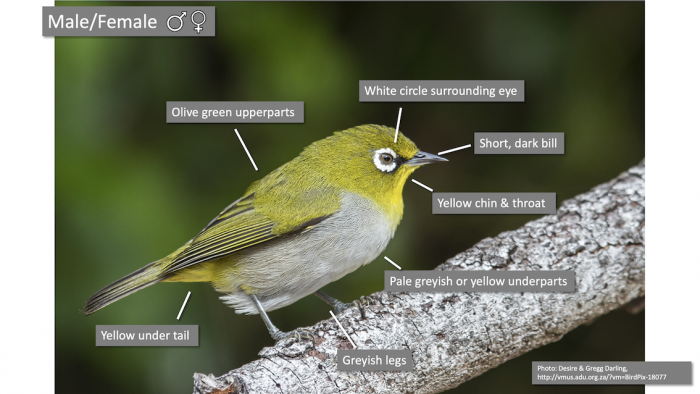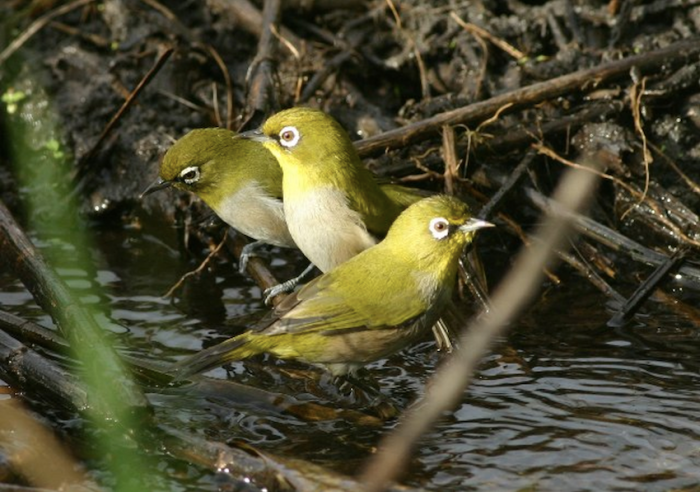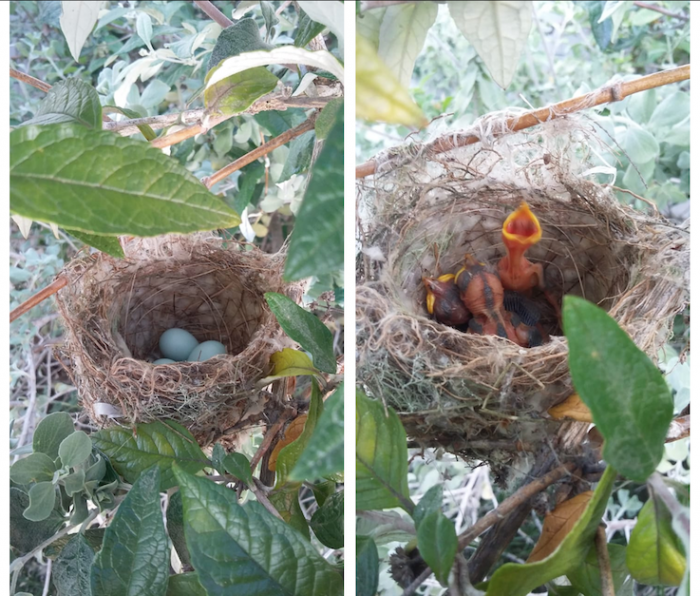Identification
The Cape White-eye is a very small, fast-moving bird. Males and females look alike but show geographic variation. This means that one species can look different in different parts of its range. The Cape White-eyes you are likely to see in Cape Town have olive green upperparts, grey or yellowish bellies, and bright yellow patches on their throats and under their tails. They have short, black bills and a characteristic circle of small white feathers around their eyes—this is where the name “white-eye” comes from!

Further north, the same species looks quite different. For instance, in Limpopo province, Cape White-eyes tend to be much more yellow overall with less of a contrast between their upperparts and underparts. Young birds anywhere in southern Africa are a duller greyish colour. Have a look at these two photos from Polokwane, Limpopo: both were taken on the same day in the same place, and believe it or not, they are the same species! The duller-coloured bird on the left is young and still growing its adult feathers, whilst the brighter yellow bird on the right is a mature adult.

If you are lucky enough to have Cape White-eyes nesting in your garden, you might glimpse a bird without a white eye ring, like the bird on the left, or a partial ring, like the bird on the right. White-eyes only develop their “white eyes” around 5 weeks of age. If you keep an eye out for these transitional stages, you may be able to work out an estimate of a bird’s age.

Cape White-eyes are very vocal, and you may find that you are already familiar with some of their repertoire. These birds usually maintain constant streams of communication with each other when flying between trees and foraging. Their trilled contact call is a distinct sound; in the early morning, listen out for their long, liquidy song, which sometimes includes mimicry of other species.
Habitat
Cape White-eyes have quite a varied diet and commonly feed on a combination of insects, fruit, and nectar. They forage in small groups, working together to scour a tree or plant for food before moving together to the next spot.

Gerald Wingate, Cape Town, South Africa. 10 January 2021. BirdPix 152153; Colin Summersgill, Weenen, KwaZulu-Natal. 13 February 2021. BirdPix 157611; Dave Rimmer, Hillcrest, KwaZulu-Natal. 7 August 2015. BirdPix 20685; Keir Lynch, Grabouw, Western Cape. 24 August 2019. BirdPix 89310
Because they consume a variety of food sources, these birds occupy a range of habitat types, including open shrubby land with scattered trees, forests and forested mountain slopes, residential gardens and parks, and scrubby vegetation alongside rivers. White-eyes are unlikely to visit birdseed feeders in gardens, but will happily feed on fruit or mealworms or have a splash in a bird bath.

Itxaso Quintana, Cape Town, Western Cape. 13 June 2020. BirdPix 115354 Lower R: Karis Daniel, Anysberg, Western Cape. 4 February 2021. BirdPix 155606
Distribution
The Cape White-eye is a southern African endemic; in other words, it does not occur anywhere else in the world outside of southern Africa.

It is common across South Africa, except for the very dry interior regions of the Northern Cape, as well as in eSwatini and Lesotho. Cape White-eyes can also be found in southeastern Botswana and along the southwestern border of Mozambique.
Behaviour
Cape White-eyes are gregarious, spending their time in pairs or small groups rather than alone. These birds usually spend the night huddled together in pairs before joining a large foraging flock very early in the morning. Flocks work through surrounding vegetation in search of food, often starting before dawn. As the day progresses, the large flock breaks off into smaller and smaller sub-groups until only a few birds or pairs remain together and eventually return to a night-time perch.

Cape White-eyes are solitary nesters, meaning that each pair of birds builds its nest away from other White-eyes. Males and females share the building responsibility, forming a tiny cup-shaped structure from whatever materials they find in surrounding vegetation.

In forests, nests may include lichen and moss; in drier regions, grasses and roots. Nests are lined with soft grass flowers and animal hair, and nests in urban areas occasionally include bits of string or fabric. They are usually constructed between two forked twigs in a shrub or tree, and can be difficult to spot.
Further resources
Species text in the first bird atlas (1997)
Virtual Museum (BirdPix > Search VM > By Scientific or Common Name)
More common names: Kaapse Glasogie (Afrikaans); Zostérops du Cap (French); Kapbrillenvogel (German); Anteojitos de El Cabo (Spanish)
Recommended citation format: Daniel KA 2021. Cape White-eye Zosterops virens. Biodiversity and Development Institute. Available online at https://thebdi.org/2021/11/3/cape-white-eye-zosterops-virens/

